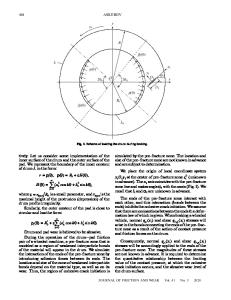Crack Initiation
- PDF / 480,776 Bytes
- 7 Pages / 504.567 x 720 pts Page_size
- 58 Downloads / 386 Views
Crack Initiation Fengzhou Fang1,2 and Min Lai1 1 State Key Laboratory of Precision Measuring Technology & Instruments, Centre of MicroNano Manufacturing Technology, Tianjin University, Tianjin, China 2 Centre of MicroNano Manufacturing Technology (MNMT-Dublin), University College Dublin, Dublin, Ireland
Synonyms Crack forming; Crack nucleation
Definition Crack initiation is the formation process of a crack, including the incubation period and the embryonic stage.
Theory and Application Introduction Fracture failure is one of the biggest threats to the structures in the engineering materials. The fracture process of materials consists of the crack initiation, crack propagation, and final parting. Apparently, the crack plays an important role in
the fracture of materials. The cracks can be produced in the process of manufacturing, assembly, and service, which are the interaction results of the material microstructures, loading condition, and environment. Generally, the performance of structures would be adversely affected by the existence of cracks. For example, the cracks in the laser crystal would reduce its laser-induced damage threshold (LIDT), the cracks in the bearing structure are likely to shorten its service life, and the cracks on the optical surface would affect its performance. Therefore, the crack initiation should be avoided or reduced as much as possible in the manufacturing of materials. Taking silicon, for instance, brittle materials easily crack during machining. However, the super smooth surface without cracks can be achieved by optimizing the process conditions and technological parameters (Fang and Venkatesh 1998). There are many kinds of classification basis for cracks. The cracks can be classified as opening-mode cracks (mode I), sliding-mode cracks (mode II), and tearing-mode cracks (mode III), as shown in Fig. 1. A cracked body can be loaded in any one of these modes or their combinations (Anderson 2005). The cracks can also be classified as surface cracks, embedding cracks, and through cracks according to their locations in the material. Based on the mode of crack propagation and the relative failure characteristics in the static loading, there are transgranular brittle cracks, transgranular ductile cracks, intergranular brittle cracks, and
# CIRP 2017 The International Academy for Production Engineering et al. (eds.), CIRP Encyclopedia of Production Engineering, DOI 10.1007/978-3-642-35950-7_16713-1
2
Crack Initiation
Crack Initiation, Fig. 1 Three kinds of cracks according to the loading
intergranular ductile cracks. Considering the physical cause for the formation of cracks, the cracks consist of weld cracks, fatigue cracks, hydrogen embrittlement cracks, stress corrosion cracks, creep cracks, and so on. On the basis of relative size to the microstructure of materials, the crack can be classified as macroscopic cracks, mesoscopic cracks, and microscopic cracks. The crack initiation is mainly involved with the microscopic cracks. Mechanism of Crack Initiation The various microstructur
Data Loading...











